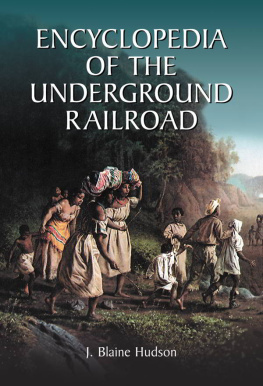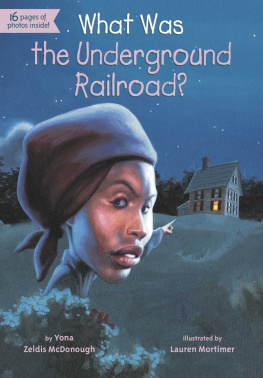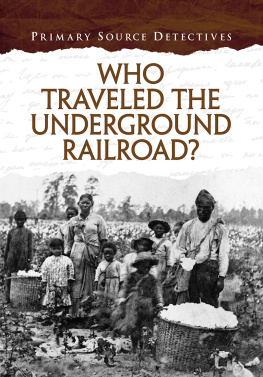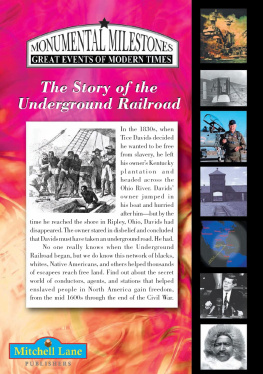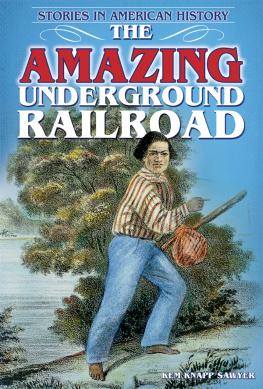J. Blaine Hudson - Encyclopedia of the Underground Railroad
Here you can read online J. Blaine Hudson - Encyclopedia of the Underground Railroad full text of the book (entire story) in english for free. Download pdf and epub, get meaning, cover and reviews about this ebook. year: 2014, publisher: McFarland, genre: History. Description of the work, (preface) as well as reviews are available. Best literature library LitArk.com created for fans of good reading and offers a wide selection of genres:
Romance novel
Science fiction
Adventure
Detective
Science
History
Home and family
Prose
Art
Politics
Computer
Non-fiction
Religion
Business
Children
Humor
Choose a favorite category and find really read worthwhile books. Enjoy immersion in the world of imagination, feel the emotions of the characters or learn something new for yourself, make an fascinating discovery.
- Book:Encyclopedia of the Underground Railroad
- Author:
- Publisher:McFarland
- Genre:
- Year:2014
- Rating:5 / 5
- Favourites:Add to favourites
- Your mark:
- 100
- 1
- 2
- 3
- 4
- 5
Encyclopedia of the Underground Railroad: summary, description and annotation
We offer to read an annotation, description, summary or preface (depends on what the author of the book "Encyclopedia of the Underground Railroad" wrote himself). If you haven't found the necessary information about the book — write in the comments, we will try to find it.
Encyclopedia of the Underground Railroad — read online for free the complete book (whole text) full work
Below is the text of the book, divided by pages. System saving the place of the last page read, allows you to conveniently read the book "Encyclopedia of the Underground Railroad" online for free, without having to search again every time where you left off. Put a bookmark, and you can go to the page where you finished reading at any time.
Font size:
Interval:
Bookmark:

Also by J. Blaine Hudson
_______________
Fugitive Slaves and the Underground Railroad in the
Kentucky Borderland (McFarland, 2002)
LIBRARY OF CONGRESS CATALOGUING-IN-PUBLICATION DATA
ISBN-13: 978-0-7864-2459-7
973.7'115dc22 2005037582
2006 J. Blaine Hudson. All rights reserved
No part of this book may be reproduced or transmitted in any form or by any means, electronic or mechanical, including photocopying or recording, or by any information storage and retrieval system, without permission in writing from the publisher.
Cover illustration 2006 Pictures Now
To my family,
lost and found, living and dead
Throughout the African diaspora, persons of African birth or ancestry challenged the practice of slave trade and the institution of slavery. However, while the determination to regain or achieve freedom was a constant, the strategies employed were highly adaptive toand the likelihood that those strategies would be successful was highly dependent onthe specific realities of enslavement in a given time and place.
In the Caribbean and Latin America, enslaved Africans greatly outnumbered whites, and the weight of superior numbers often compensated for decisive European advantages in weaponry. Not surprisingly, large-scale revolts and, where geography permitted, the formation of autonomous maroon settlements in remote areas were relatively common. In contrast, Africans enslaved in colonial America and later the antebellum United States, except in rare cases, were themselves a numerical minority. Being outnumbered and outgunned, they could not overcome the power of whites through violent means. Being defined as property, they had no standing under American law and could not free themselves legally. Thus, in the United States, two strategies proved most effective in challenging slavery:
the antislavery or abolitionist movement, i.e., the political struggle against the peculiar institution that brought together whites opposed to slavery and free people of color working to liberate their kinsmen; and
running away from slavery, i.e., crossing the political and geographic boundary between slave and free territory was, despite the obvious risks, a more practical and effective strategy of resistance.
The first strategy embodied the efforts of those who were not enslaved to free those who were. The second embodied the efforts of those who were enslaved to free themselves. The history of fugitive slaves and the Underground Railroad weaves together these two historical narratives.
The first Africans were brought to colonial America in August 1619, and slave escapes were recorded as early as the 1640s. With slavery legal in all British North American colonies, freedom seekers from the Carolinas and later Georgia tended to flee south instead of north in hopes of finding freedom in Spanish Florida. Runaways from Virginia tended to flee north or west to the often friendly Native American societies living beyond the frontier. In most regions, flight to the swamps, the mountains or simply the backcountryand the consequent formation of maroon settlementswas not uncommon. As a result, by the 1700s, fugitive slave notices became a standard feature in early American newspapers. Further, by employing this established strategy of resistance in the confusion of the American Revolution, an estimated 100,000 African Americans escaped from bondage, fleeing to Canada, or to the Spanish or French colonies, or forming short-lived maroon colonies in Georgia, North Carolina, New York, New Jersey and Virginia.
The division of the United States into free and slave zones in the generation following independence created a border within the country and the need to define the legal meaning of that border as it related to fugitive slaves. As a consequence, Article IV, section 2.3 of the U.S. Constitution makes a crucial distinction between fugitives from justice and fugitive slavesspecifically, that a fugitive slave retained slave status even in free territory and was subject to recapture by his or her owner. To enforce this provision, the Second Congress passed An act respecting fugitives from justice, and persons escaping from the service of their masters on February 12, 1793, authorizing the arrest or seizure of fugitives and empowered any magistrate of a county, city or town to rule on the matter. Still, however precise its language and however severe its penalties for those who assisted freedom seekers, the law did little or nothing to deter escape attempts by freedom seekers themselves.
As individuals, fugitive slaves were a unique subset of the total population of enslaved African Americans. According to Franklin and Schweninger (1999) and Hudson (2002), freedom seekers were predominantly young and male and more likely to be racially mixed than African Americans in the aggregate. Fugitive slaves escaped in reaction to or to avoid brutality, sexual exploitation, separation from familyand in response to broken promises, or simply because freedom beckoned. They escaped alone or in small groups, with women and children more likely to flee in the 1850s than beforeand, in most cases, with little or no assistance. Slave escapes occurred more frequently on the weekends and, by the 1840s, in the cooler months. In planning their journeys, freedom seekers relied on shreds of information gleaned from travel or travelers, from the slave grapevine and occasionally from friends of the fugitive operating covertly in the South. In preparation for flight, they hoarded or stole clothes, food, money and, if possible, weapons. In more elaborate escapes, fugitives often concocted deceptions and employed various disguises. Then they fled toward free territory, e.g., Pennsylvania, the Ohio River area, Mexico, or Native American territory, converging on towns and urban centers with significant black populations or cities farther north with significant antislavery factions.
From the Revolutionary period through the Civil War, slave escapes were more than a trickle, but less than a flood. While many escapes from the deep southern interior were acts of protest that did not have freedom as their ultimate goal, those that did followed certain broadly predictable and similar patterns. Of course, the first task faced by freedom seekers was escaping slave territory. In some cases, help could be found in the South itself. For example, there were counties in Mississippi where enslaved African Americans were two-thirds of the population, but other counties in which only one percent of the population was black. Similar demographic and political patterns could be founds in parts of the Carolinas, Georgia, Alabama, Tennessee, and Texas. The whites in these sections of the South were seldom friends to slaveholders and some were occasionally friends to African Americans seeking freedom through flight. Although distance to free soil was a formidable barrier to would-be fugitives, freedom seekers living near the Mississippi River or the Atlantic coast or the Gulf of Mexico did have slightly better odds if they could escape by sea. Of course, in Texas, freedom seekers could flee either to Mexico, the West or the North.
Next pageFont size:
Interval:
Bookmark:
Similar books «Encyclopedia of the Underground Railroad»
Look at similar books to Encyclopedia of the Underground Railroad. We have selected literature similar in name and meaning in the hope of providing readers with more options to find new, interesting, not yet read works.
Discussion, reviews of the book Encyclopedia of the Underground Railroad and just readers' own opinions. Leave your comments, write what you think about the work, its meaning or the main characters. Specify what exactly you liked and what you didn't like, and why you think so.

